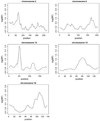Genome-scan for IQ discrepancy in autism: evidence for loci on chromosomes 10 and 16
- PMID: 20963441
- PMCID: PMC3082447
- DOI: 10.1007/s00439-010-0899-z
Genome-scan for IQ discrepancy in autism: evidence for loci on chromosomes 10 and 16
Abstract
Performance IQ (PIQ) greater than verbal IQ (VIQ) is often observed in studies of the cognitive abilities of autistic individuals. This characteristic is correlated with social and communication impairments, key parts of the autism diagnosis. We present the first genetic analyses of IQ discrepancy (PIQ-VIQ) as an autism-related phenotype. We performed genome-wide joint linkage and segregation analyses on 287 multiplex families, using a Markov chain Monte Carlo approach. Genetic data included a genome-scan of 387 micro-satellite markers in 210 families augmented with additional markers added in a subset of families. Empirical P values were calculated for five interesting regions. Linkage analysis identified five chromosomal regions with substantial regional evidence of linkage; 10p12 [P = 0.001; genome-wide (gw) P = 0.05], 16q23 (P = .015; gw P = 0.53), 2p21 (P = 0.03, gw P = 0.78), 6q25 (P = 0.047, gw P = 0.91) and 15q23-25 (P = 0.053, gw P = 0.93). The location of the chromosome 10 linkage signal coincides with a region noted in a much earlier genome-scan for autism, and the chromosome 16 signal coincides exactly with a linkage signal for non-word repetition in specific language impairment. This study provides strong evidence for a QTL influencing IQ discrepancy in families with autistic individuals on chromosome 10, and suggestive evidence for a QTL on chromosome 16. The location of the chromosome 16 signal suggests a candidate gene, CDH13, a T-cadherin expressed in the brain, which has been implicated in previous SNP studies of autism and ADHD.
Conflict of interest statement
Figures



References
-
- Alarcon M, Yonan AL, Gilliam TC, Cantor RM, Geschwind DH. Quantitative genome scan and ordered-subsets analysis of autism endophenotypes support language QTLs. Mol Psychiatry. 2005;10:747–757. - PubMed
-
- Alm J, Kaufman AS. The Swedish WAIS-R factor structure and cognitive profiles for adults with dyslexia. J Learn Disabil. 2002;35:321–333. - PubMed
-
- Anney R, Klei L, Pinto D, Regan R, Conroy J, Magalhaes TR, Correia C, Abrahams BS, Sykes N, Pagnamenta AT, Almeida J, Bacchelli E, Bailey AJ, Baird G, Battaglia A, Berney T, Bolshakova N, Bolte S, Bolton PF, Bourgeron T, Brennan S, Brian J, Carson AR, Casallo G, Casey J, Chu SH, Cochrane L, Corsello C, Crawford EL, Crossett A, Dawson G, de Jonge M, Delorme R, Drmic I, Duketis E, Duque F, Estes A, Farrar P, Fernandez BA, Folstein SE, Fombonne E, Freitag CM, Gilbert J, Gillberg C, Glessner JT, Goldberg J, Green J, Guter SJ, Hakonarson H, Heron EA, Hill M, Holt R, Howe JL, Hughes G, Hus V, Igliozzi R, Kim C, Klauck SM, Kolevzon A, Korvatska O, Kustanovich V, Lajonchere CM, Lamb JA, Laskawiec M, Leboyer M, Le Couteur A, Leventhal BL, Lionel AC, Liu XQ, Lord C, Lotspeich L, Lund SC, Maestrini E, Mahoney W, Mantoulan C, Marshall CR, McConachie H, McDougle CJ, McGrath J, McMahon WM, Melhem NM, Merikangas A, Migita O, Minshew NJ, Mirza GK, Munson J, Nelson SF, Noakes C, Noor A, Nygren G, Oliveira G, Papanikolaou K, Parr JR, Parrini B, Paton T, Pickles A, Piven J, Posey DJ, Poustka A, Poustka F. A genome-wide scan for common alleles affecting risk for autism. Hum Mol Genet. 2010;19:4072–4082. - PMC - PubMed
Publication types
MeSH terms
Substances
Grants and funding
LinkOut - more resources
Full Text Sources
Miscellaneous

